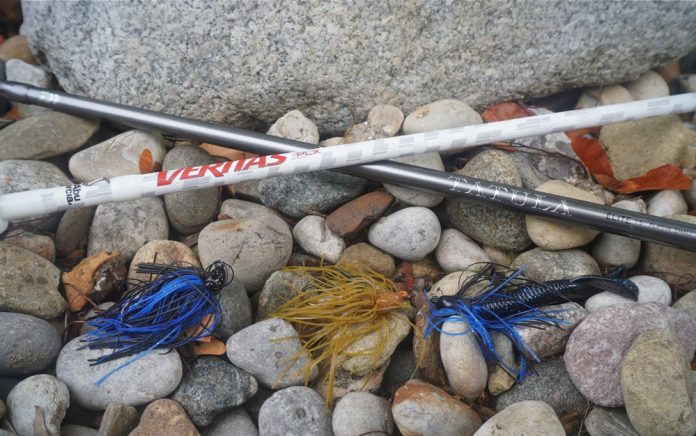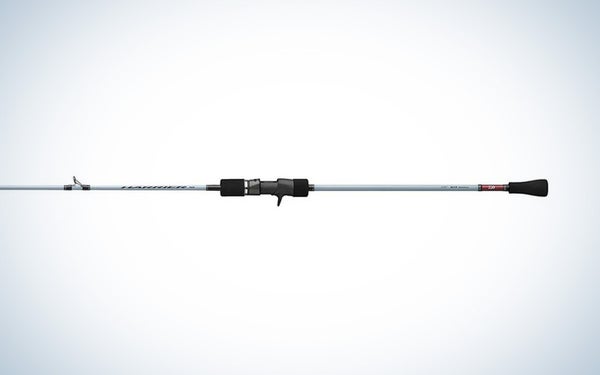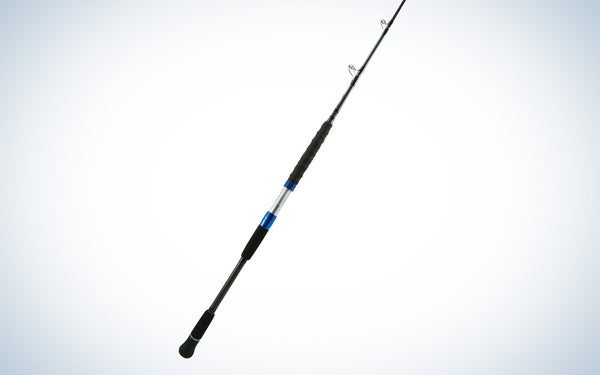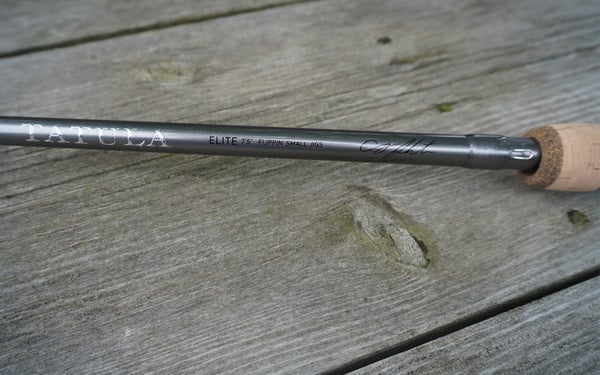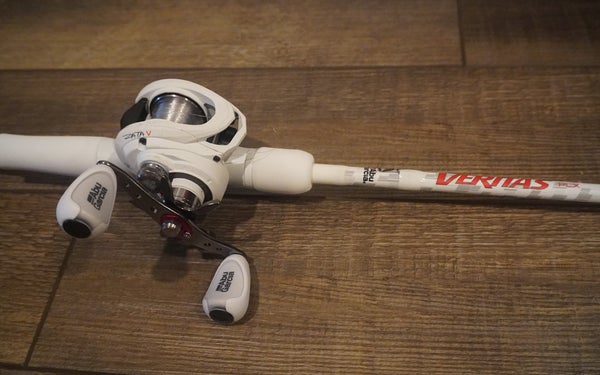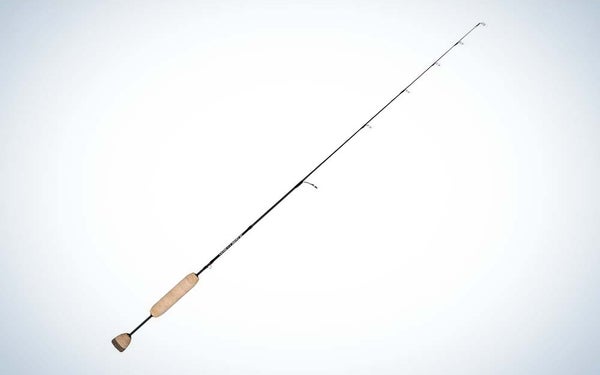We may earn revenue from the products available on this page and participate in affiliate programs. Learn more ›
Published Jun 30, 2023 1:00 PM
Because jigging is one of the most effective and versatile forms of fishing, you can find jigging rods for a whole host of different species and scenarios, whether you’re catching tiny panfish through the ice or monstrous grouper lurking hundreds of feet beneath the surface miles offshore. The beauty of jigging is that it’s one of the easiest techniques to learn—yet it’s also difficult to master. Jigs can imitate everything from a crayfish scampering across the bottom to a baitfish in a series of tantalizing death throes. Both are extremely hard for any predatory fish to resist striking.
Trying to pick a good jigging rod can be overwhelming as there are so many brands and styles. While we can’t possibly cover all the rods out there, we chose to test and review some of the more popular ones to the test from brands like Penn, Daiwa, and Abu Garcia. Whether you plan to head far offshore, or just jig fish for bass in a few feet of water, these are the best jigging rods being made today.
How We Picked the Best Jigging Rods
Field & Stream staff members personally tested some of these fishing rods, mostly the freshwater ones. I tested a few of them myself both here in Michigan and on saltwater press trips as far away as Costa Rica. We tested the rods during normal fishing conditions using standard techniques for the areas and species targeted.
However, we also dove into the specs and features of each rod to help determine what’s going to work best for different types of fishing. We tried to find rods that are purposely designed for different jigging techniques. Among the more important features we considered were the following:
- Case Use: Is this a casting rod meant for flipping under docks for bass? Or is it a heavier slow pitch rod meant for catching saltwater fish more than a hundred feet deep?
- Construction: How many pieces is the rod? What type of blank construction does it utilize? How does that affect the sensitivity?
- Type: Is this a conventional rod meant mainly for offshore purposes? Or is it a spinning rod that works best at moderate depths inshore?
- Action and Power: Are the action and power of the rod appropriate for jigging?
- Value: How do the features and construction of the rod compare to the price? Is the rod versatile for fishing techniques beyond jigging? Is this a great rod for beginners?
Best Jigging Rods: Reviews and Recommendations
Best Slow Pitch: Daiwa Harrier Slow Pitch
Specs
- Type: Conventional
- Powers: M, MH, H, XH
- Action: Moderate
- Length: 6’ 6”
- Construction: Graphite one-piece
Pros
- Solid price point
- Purpose-driven handle design
- Five-year warranty
Cons
Slow-pitch saltwater jigging is yet another fantastic vertical angling technique that originated in Japan and has since migrated around the globe because it’s so darn effective. Daiwa purposely built the Harrier Slow Pitch specifically for this technique. To start, the thin rod and minimal handle allow you to tuck the rod butt under your arm while working the lure. It gives the rod a bit of an odd look, but it also makes it highly effective for the technique. This rod may not look very tough, but it has an excellent backbone for cranking larger fish up from great depths.
There are other dedicated fishing rods for slow pitch, but we love the sensitive nature of Daiwa rods, specifically this one. Plus, it costs $200, which is a fair price for the quality. For the angler just getting started in slow pitch, this is an ideal way to do it.
Best Saltwater: Penn Carnage III
Specs
- Type: Spinning
- Powers: L, ML, M, MH, H
- Actions: Moderate, Moderate Fast
- Lengths: 6’, 6’ 6”, 7’, 8’
- Construction: Graphite and fiberglass
Pros
- Great reel seat
- Quality guides
- Very versatile for more than just jigging
Cons
The Penn Carnage III is a rod I got to fish with in Costa Rica just before its release and I loved the feel and sensitivity. Penn gave this rod some excellent Fuji K-series guides and the shrink tube handle is very comfortable when fighting larger saltwater fish. This is a rod that transitions from inshore to offshore rather easily. It’s also not a jigging-specific rod, so it’s a solid option for anyone who wants a versatile rod that can do a little of everything in the salt.
I caught the largest fish I’ve ever tangled with in fresh or salt with this rod: a feisty 91-pound yellowfin tuna that delivered a roughly 45-minute battle before the captain and deckhand could finally gaff it. That proved to me this saltwater rod has some serious backbone for the ocean’s larger and stronger fish.
Most Versatile: Bubba Tidal Pro
Specs
- Type: Spinning
- Powers: ML, M, MH, H
- Action: Fast
- Lengths: 7’, 7’ 6”
- Construction: Graphite
Pros
- Versatile for fresh and saltwater
- High quality guides
- Great grip for casting
Cons
- Feels a hair overpriced
- Scratches easily
The Bubba Tidal Select is designed mostly for inshore fishing scenarios, but it also works great for larger fish like lake trout in freshwater. Bubba didn’t skimp on most of the components of this rod, especially the Fuji double-locking reel seat and K-Guides. I’ve been a big fan of Bubba’s rubber grips for a while now. These grips have just the right amount of “tact” to them to prevent slipping. In the Tidal Select’s case, it will help launch some longer casts.
While the $300 price tag is a little daunting, Bubba backs their rods with a limited lifetime warranty. We like the Tidal Pros mostly for shallow inshore jigging scenarios. But it has some good backbone to go offshore for larger fish, too. This isn’t strictly a jigging rod either, which means there’s a good deal of value here.
Best Offshore: Okuma Cederos A
Specs
- Type: Conventional
- Powers: M, MH, H, XH, XXH
- Action: Moderate Fast, Fast, Extra Fast
- Lengths: 7’ 6”, 8’
- Construction: E-glass
Pros
- Extremely heavy backbone
- Rugged components
- Limited lifetime warranty
Cons
- Sensitivity could be a little better
If you are planning to go offshore to catch larger species like tuna, the Cederos is a solid choice that won’t break the bank. The EVA grips add some nice ergonomics for a long day on the water pulling big fish up from the depths. This rod is notoriously stiff and that hurts the sensitivity a little. But Okuma has made the rod surprisingly affordable considering the quality of the components used. With line weight ratings between 30 and 200 pounds, there’s a nice variety of options available.
The Cederos rod is solid for mid-sized fish upwards of 70 pounds. We like it for tuna, halibut, albacore, lingcod, amberjack, mahi-mahi, grouper, and more. This is one of the most affordable offshore rods being made today. Thus, it’s also our top pick for a budget rod for saltwater jigging.
Best For Flipping and Pitching: Daiwa Tatula Elite
Specs
- Type: Baitcasting
- Power: H
- Action: Fast
- Length: 7’ 5”
- Construction: Graphite
Pros
- Great durability
- Excellent feel
- Quality grips
Cons
- Hook holder is a bit small
I only recently began fishing the Tatula line and have found these rods offer some of the best sensitivity I’ve ever encountered in a freshwater rod. There are a few different variants of the Tatula Elite, but the one I tested for this review was the 7’ 5” flippin’ small jig designed by Bassmaster Pro Cory Johnston. I love the ergonomics of the handles on the Tatula series. They are some of the most comfortable rods I’ve ever used while fishing for long periods.
This rod has a solid backbone to it and hook sets with the Tatula feel very crisp and solid. I also just like the quality of the components Daiwa used here. The reel seat doesn’t take much to lock down and it feels very solid. Considering the quality of this rod, I was rather surprised at the highly affordable sub $200 price point. Daiwa has produced some real bargains with this line.

Best Bass Combo: Abu Garcia Veritas Baitcast Combo
Specs
- Type: Baitcasting
- Powers: H, MH
- Action: Fast
- Lengths: 7’ and 7’ 3”
- Construction: Graphite
Pros
- Extremely smooth
- Good ergonomics
- Durable
Cons
- White color shows a lot of dirt
There are a lot of good rod and reel combos. But I’ve owned the Veritas for a couple years now and recently got a second one because I liked the first one so much. Both the rod and reel of this combo offer an incredibly smooth operation. I also like the sensitivity it delivers while working a jig along the bottom. I’ve found the Veritas to be a solid sight fishing rod as it pitches and flips rather well. It’s also got a strong backbone that’s not overly heavy for Michigan bass, which generally don’t grow as large as other parts of the country.
The only real downside to this rod is that I need to clean it more frequently than others I own because of the entirely white coloration. I would love to see a darker alternative color in the future from Abu Garcia because the Veritas rod and reel combos deliver an excellent amount of value, especially for newer anglers looking to level up their gear.

Best Ice Fishing: G. Loomis IMX-PRO
Specs
- Type: Spinning
- Powers: L, ML, M, MH
- Action: Fast, Extra Fast
- Lengths: 29” – 41”
- Construction: Graphite
Pros
- Versatile for multiple species
- Excellent sensitivity
- Lightweight
Cons
When it comes to jigging for larger fish like lake trout or pike, G. Loomis has an impressive lineup of rods in the IMX-PRO series. These graphite rods are very sensitive and have some great flex that helps get the most action out of your favorite spoons and jigs. We also like the added durability from the REC Recoil guides, which will snap right back into place as if nothing happened even if you literally bend them backwards. That makes this rod a good choice for anyone who is rough on their gear.
Another great thing about these ice fishing rods is the plethora of lengths, powers, and actions available G. Loomis also offers three different grip variations, so there’s something to suit every ice angler’s needs here. While $200+ might be expensive for a rod that only sees use a few months of the year, this is also a setup that will last for years.
What to Consider When Choosing a Jigging Rod
Jigging is one of those deceptively simple techniques where you might assume not much is involved. However, there’s a lot to consider in terms of action and power when selecting the best jigging rod.
Action
Action refers to the stiffness of the rod or how much weight it takes to make it flex. Most jigging scenarios call for an action that helps the rod tip flex and impart an enticing movement to the jig. Fast jigging in saltwater, ice jigging, and most normal jigging techniques call for a fast or extra fast action because there needs to be some slack in the line on the fall. A fast reel is needed to take up this slack quickly for optimal action and hook sets.
But there is a major exception in slow pitch because the technique utilizes the flex of the rod to help impart action and flutter to the lure. Consequently, a slow action is better for slow pitch because more of the rod flexes around the entire length. Most slow pitch experts will recommend a rod that fully unloads straight on each sweep of the rod. Slow actions are great for setting the hook, too, which is helpful when your presentation is hundreds of feet down.
Power
Power refers to the actual amount of flex is in the rod and how quickly it bends. When it comes to power, this is more technique-specific than anything else. But in most cases a heavier rod is better. For instance, if you’re punching a jig through grass mats for bass, a heavy action is preferable to get the jig through the slop. It also comes in handy when it comes time to pull a fish out of that kind of mess. Most hook sets are going to be upward into the roof of the fish’s mouth, and a heavier power helps ensure the hook is driven home with no chance of coming loose.
FAQs
Q: Do I need a special rod for jigging?
While you can jig with just about any rod, buying a rod that’s specifically designed for the task at hand will result in better strike detection and more hook-ups on fish. Depending on the style of jigging, fish can strike when the jig is falling and that can be hard to detect with some styles of rod. Especially when it comes to techniques like slow pitch jigging that are not nearly as aggressive.
Q: What size rod is good for jigging?
This depends entirely on the type of fishing you plan to do. Anyone jigging in saltwater will need a longer and stouter rod while an ice fisherman needs something shorter with a good deal of action in the tip. For bass fishing, most of the pros go with a rod that’s at least 7’ 3” or 7’ 6” in length.
Q: What is the difference between a slow jigging rod and a fast jigging rod?
The main difference between fast and slow-pitch jigging is in the action. Most jigging presentations call for a fast action rod with a flexible tip. But slow pitch calls for a much slower action where the movements of the rod help impart a “flutter” to the lure that helps it imitate a dying baitfish. Conventional rods are preferred by most of the pros, but the technique can be done with spinning gear too.
Q: What reel speed is best for jigs?
For bass fishing, a higher gear ratio of 7.1:1 to 8.1:1 is usually preferable. This is because jigging is a technique done primarily with the rod itself. When a fish takes your jig, odds are it will be on the fall. If it does, there will probably be slack in the line. A higher gear ratio helps make up the difference. If you’re missing a lot of strikes with your jigs, try switching to a reel with a higher ratio until you start hooking fish.
Best Jigging Rods: Final Thoughts
Although the basics of jigging have remained largely unchanged, the technique continues to evolve, both in the styles of jigs that are available, and in the fine-tuning of the rods to fish different depths and scenarios. While you can’t miss with any of the best jigging rods on this list, the Penn Carnage III is our choice for the top saltwater rod while the Daiwa Tatula is our choice for the number one bass rod. These two options deliver a lot of value and versatility hat are important for jigging.
Why Trust Us
For more than 125 years, Field & Stream has been providing readers with honest and authentic coverage of outdoor gear. Our writers and editors eat, sleep, and breathe the outdoors, and that passion comes through in our product reviews. You can count on F&S to keep you up to date on the best new gear. And when we write about a product—whether it’s a bass lure or a backpack—we cover the good and the bad, so you know exactly what to expect before you decide to make a purchase.

